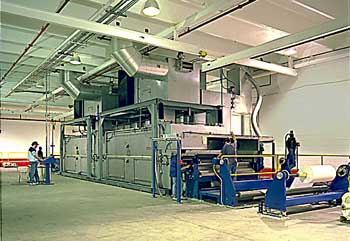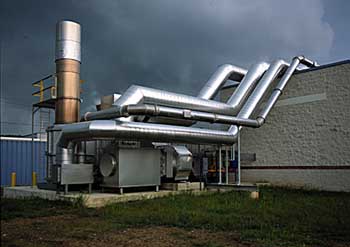Thermal Oxidizer Basic to Company's Operation
The company uses 20 different silicone formulas to coat fabrics that include nylon, cotton, glass fiber, polyester, DuPont's Nomex and Kevlar—plus others.
Key elements of the coating system include a 40-ft-long flotation dryer designed for use with organic rubber, silane, dispersion, and silicone-coated glass fabric.
To alleviate the problems typically associated with solvent use, Aldan installed a direct-fired thermal-oxidation system from Glenro, Inc. to work in conjunction with a Genik (now known as Combined Converting Systems) coating line. (Genik had worked with Glenro before in producing such equipment.)
In fact, according to James Chupella, Aldan vice president of operations, the design of the facility was centered around the Glenro equipment.

The thermal-oxidation system is intended to eliminate organic hydrocarbon contaminants in the exhaust air stream prior to discharge into the atmosphere. The unit design ensures an oxidation temperature greater than 1,400° F. Indeed, the Glenro system eliminates organic hydrocarbon contaminants throughout virtually every aspect of the fabric-coating process.
Chupella said, "We were able to capture 100% of the vapors and route them directly to the oxidizer. It eliminated a lot of the potential sources of fire associated with these types of coaters [that we use], because there is no indirect gas fire or electric coils to ignite the solvent. There are no ignition points in the building itself, which is important when dealing with solvents."
Once the solvents ignite they provide much of the heat energy required to maintain the oxidizers' set temperature, thereby providing high efficiency at low operating cost.
The integrated heat-recovery system uses the heat generated by the VOC's destruction to return clean, heated air to the dryer for use as makeup air.
"The Glenro system also has a safety feature," Chupella says, "that automatically shuts the coating line down if the... solvent in the air reaches a pre-set concentration limit, typically 42%."
All of the previously mentioned factors were key to choosing the Glenro equipment when the 125,500-sq-ft start-up facility was launched in early 1997, explained Chupella.
Although this sophisticated system was not the only way for Aldan to address the solvent issue, it was the most cost-efficient way of doing what Aldan wanted to do when the plant was built and would want to do later—since the Glenro system was designed with future expansion in mind.

"This was planned so that we could double our capacity quickly," says Chupella. Specifically the Glenro system was built to accommodate the.emissions from another Combined Converting Coater with the addition of a second, smaller oxidizer.
"The design leaves latitude and production versatility," Chupella says. "If we run both coaters, we can run both oxidizers. If we're only running one coater, we can choose which oxidizer to operate. In the event of a mechanical breakdown, we can continue to operate by crosslinking oxidizers."
The first Combined Converting unit was installed in April 1998 and approached 25% capacity by summer.
Aldan was founded in 1908 in Philadelphia, where it still maintains its headquarters. The Danville facility was launched in early 1997.
The previous case study was adapted from an article published in the August 1999 issue of Textile World.
